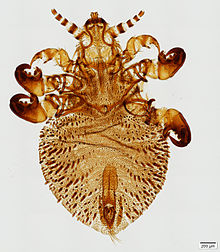
Carpenter bees are species in the genus Xylocopa of the subfamily Xylocopinae. The genus includes some 500 bees in 31 subgenera. The common name "carpenter bee" derives from their nesting behavior; nearly all species burrow into hard plant material such as dead wood or bamboo. The main exceptions are species in the subgenus Proxylocopa, which dig nesting tunnels in suitable soil.

The Ulidiidae or picture-winged flies are a large and diverse cosmopolitan family of flies (Diptera), and as in related families, most species are herbivorous or detritivorous. They are often known as picture-winged flies, along with members of other families in the superfamily Tephritoidea that have patterns of bands or spots on the wings. Some species share with the Tephritidae an unusual elongated posteroapical projection of the anal cell in the wing, but can be differentiated by the smoothly curving subcostal vein. Two species, Tetanops myopaeformis and Euxesta stigmatias, are agricultural pests.

The Micropezidae are a moderate-sized family of acalyptrate muscoid flies in the insect order Diptera, comprising about 500 species in about 50 genera and five subfamilies worldwide,. They are most diverse in tropical and subtropical habitats, especially in the Neotropical Region.

The Stephanidae, sometimes called crown wasps, are a family of parasitoid wasps. They are the only living members of the superfamily Stephanoidea. Stephanidae has at least 345 living species in 11 genera. The family is considered cosmopolitan in distribution, with the highest species concentrations in subtropical and moderate climate zones. Stephanidae also contain four extinct genera described from both compression fossils and inclusions in amber.
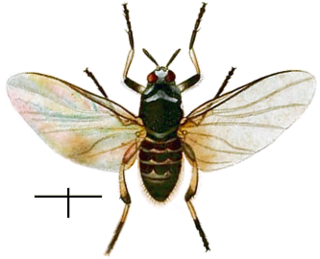
Simulium is a genus of black flies, which may transmit diseases such as onchocerciasis.

The Pyrgotidae are an unusual family of flies (Diptera), one of only two families of Cyclorrhapha that lack ocelli. Most species are "picture-winged", as is typical among the Tephritoidea, but unlike other tephritoids, they are endoparasitoids; the females pursue scarab beetles in flight, laying an egg on the beetle's back under the elytra where the beetle cannot reach it. The egg hatches and the fly larva enters the body cavity of the beetle, feeding and eventually killing the host before pupating. In the United States, some species of Pyrgota and Sphecomyiella can be quite common in areas where their host beetles are abundant. Like their host beetles, these flies are primarily nocturnal, and are often attracted to artificial lights.
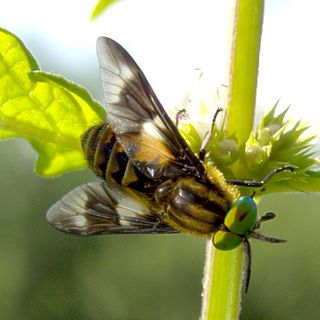
Superfamily Tabanoidea are insects in the order Diptera.
Prosimuliini is a tribe of black flies. It contains over 140 living species, with more than a half of them in the genus Prosimulium. There are 6 living genera, and 2 genera that are only known from Cretaceous fossils.
Timia is a genus of flies in the family Ulidiidae, which is difficult to separate from the genus Ulidia.

Echinophthiriidae is a family of lice in the suborder Anoplura, the sucking lice. This family of lice are parasites of seals and the river otter, and are the only insects that infest aquatic hosts.
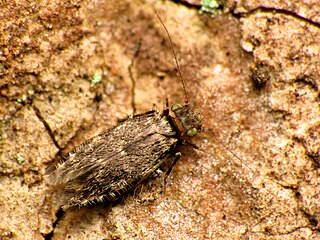
Lepidopsocidae are an insect family of bark lice belonging to the suborder Trogiomorpha. Colloquially, Lepidopsocidae are referred to as the Scaly-winged Barklice. There are more than 220 species described worldwide. Phylogenetic DNA analysis of relationships between families in Trogiomorpha propose that Lepidopsocidae is monophyletic, meaning that the taxa within all share a common ancestor. This is supported morphologically by the presence of scales and setae covering the body and forewings of Lepodopsocids. Sister families of Lepidoposcidae include Trogiidae and Psoquillidae.

Echmepteryx is a genus of scaly-winged barklice in the family Lepidopsocidae. There are more than 80 described species in Echmepteryx.

Lichenomima is a genus of mouse-like barklice in the family Myopsocidae. There are more than 40 described species in Lichenomima.

Stimulopalpus is a genus of tropical barklice in the family Amphientomidae. There are at least 30 described species in Stimulopalpus.

Phalacrotophora is a genus of scuttle flies. There are at least 50 described species in Phalacrotophora.
Psyllipsocus is a genus of cave barklice in the family Psyllipsocidae. There are more than 50 described species in Psyllipsocus.

Sciomyzinae is a subfamily of flies in the family Sciomyzidae.

Evania is a genus of ensign wasps in the family Evaniidae. Like all members of the family, they are cockroach egg parasitoids. There are more than 60 described species in Evania. Evania appendigaster, the blue-eyed ensign wasp, is a common wasp found through most of the world.
Semidalis is a genus of insects belonging to the family Coniopterygidae.
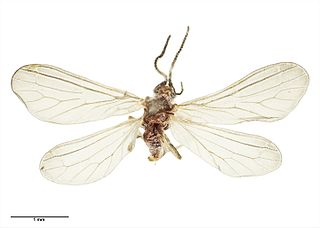
Cryptoscenea is a genus of lacewings belonging to the family Coniopterygidae.
